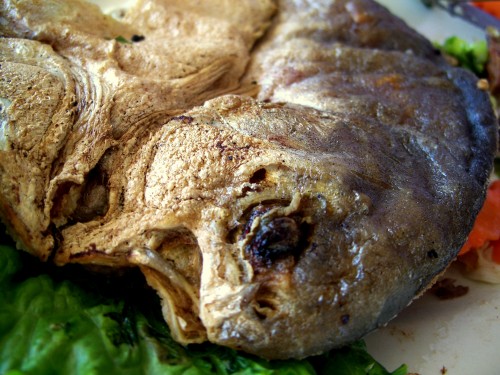 The literal translation is “highland”, but for most Vietnamese the word Cao Nguyên brings to mind images of eye-soothing green terraces, people of ethnic minorities in colorful traditional dresses and hoop and ring jewelries, dancing around the fire, drinking rice wine with a meter-long straw out of a communal urn, and simple but sturdy stilt houses above ground. In San Jose, Cao Nguyên restaurant has the decor up to theme with an urn and straws in the corner, and a painting of a highlander couple dressed in their most comfortable attire, a wrap from the waist down, by the fire. (This blog is rated G so I’m not gonna upload a picture of the painting.) The menu, though, isn’t particularly highlandish. At first glance it is similar to most other Vietnamese restaurants, and diners here also order the similar things they always order: hot pots and noodle soups. But if we’re to say that Lemon Grass has more single-portion dishes (the way we always do at American restaurants) and Thảo Tiên‘s focus is Mekong Delta noodle soups, then Cao Nguyên is the place to go […]
Continue reading Cao Nguyen in San Jose
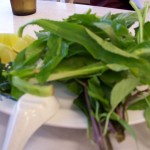 Chain means reliability. Berkeley’s snobbish take against big franchise and corporations plays to my blogging advantage, but there always lies the uncertainty. It could be a very good looking, cozy little restaurant with quaint menus, and mediocre food. They could have a long line of people waiting in the cold to be seated, and mediocre food. Somehow people sitting about you are all hyped up by the new raw or vegan order, but you just can’t enjoy yours because it’s mediocre food. When a business is the only of its name, there’s just no guarantee that it’s palatable to everyone, no matter how many stars it gets on Yelp or votes by the locals. Franchise takes care of that. I don’t know how. But I haven’t met anyone who doesn’t objectively like Burger King, Subway, Yogurt Land, KFC, et cetera (I say “objectively” because taste buds can be clouded by health conscience, religious reasons and who knows what). Some Vietnamese businesses, though still in much smaller scale, have also established their chain names. For banh mi, we almost always go to Lee’s Sandwiches or Huong […]
Continue reading Pho Danh – Making a name
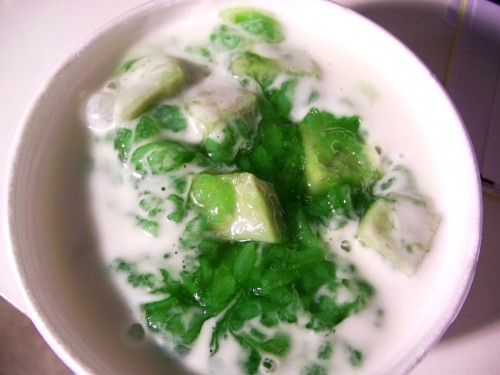 Do you have those times when you keep craving something sweet, even after you wiped clean a cereal bowl worth of Double Fudge Brownie, exterminated many prunes, and skillfully chewed up four pirouette cookies like a mafia boss smoking cigars? I’ve started to see such danger of staying up late, but sweet stuff is always easier to eat than savory stuff in those wee hours. To avoid having my belly exceed my face, I started going through pictures of food (it helps more than studying and thinking about food), and found some munchtastic sweet treats I meant to but never got around to blog about. 1. Chè khoai môn (taro che) One of the few country treats without mung bean paste. Depending on each root and how long it’s cooked, the purplish pale taro cubes can be grainy, nutty, a little chewy, or al dente, like scallop potato minus the butter. However they are, they serve as a textural contrast to the gooey pudding-like sticky rice base. I’m particularly charmed by the vibrant green color in this Lee’s Sandwiches‘ rendition, hopefully from pandan leaf extract. You know it’s a skilled cook when the […]
Continue reading More starchy sweets
 The laminated page has Goi Cuon next to Fritures de Calmars, Bo Luc Lac between Rossini style Tournedos and Agneau. Funny interlingual names like “Ap Chow Bo” and “Ap Chow Hai San” precede English descriptions of stir fries. Don’t bother google “ap chow”. Such innovative term doesn’t exist outside the menu of Bodega Bistro. Just like the dialogues between Jim and Huckleberry Finn, names like these can’t be understood unless you speak it out loud in your head. Ap chow is áp chảo, “press against the pan”, a Vietnamese way of saying pan fry. Why did the chef phonetically transform it into Chinese, while keeping Goi Cuon and Bo Luc Lac true to their original spellings? I don’t know, but I got a chuckle out of it. The menu alone, however, didn’t strike me as anything unusual. This wasn’t the first time I had to decode a strange name for a familiar dish. Vietnamese menus tend to have such mix between trying to keep the Vietnamese name and (mis)translating it into some other language. The unusual thing was that our thought-to-be-Vietnamese waiter didn’t understand me when I said the dishes’ names […]
Continue reading Bodega Bistro – Defining authenticity
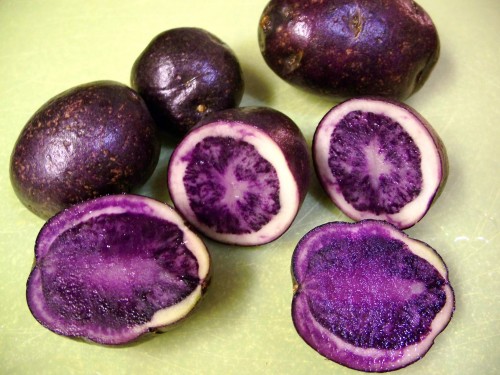 If you walk into my house you’re not gonna see many purple things. Truth is, I think purple is a picky color, even more so than pink. The wrong purple is tacky, the right purple rarely happens. But somehow all purple foods taste good (except eggplant). Purple cabbage, purple lettuce, beet, taro (mmm, taro ice cream), blueberry, purple spinach. Then I ran into purple potatoes at Lucky. I bet you can carve your initials and use it as a stamper. At first I thought they are some cross between normal potato and beet, with the beet’s juicy crunch apparent whatever way you slice. Turns out it’s a mutation that causes production of the antioxidant anthocyanin, giving it the ink-stain color. So it’s all potato. Mudpie the chef sliced them. Stir fry with salt, pepper, garlic powder, tarragon until golden. Continue reading Down the Aisles 3: Ink stamper or potato?
 If you’re going to open a restaurant, where will it be? The city center where hungry passengers get on and off the subway station, a shopping mall where everyone gets the thirst for icy juice, the busiest street bordering campus, or a quiet neighborhood? If steaming delicious carts and baskets are literally a stone’s throw from your door in Vietnam, more often than not you need to wheel yourself a good ten minutes from home to burger joints and pizzerias here. There’s the eatery hub, then there’s the residential neighborhoods wrapping around it. So I could imagine how comfortable the folks living near 8th Street of East Oakland must feel, waking up on a lazy weekend midday. Hey, how about a bowl of kaow piak? Sure, Champa Garden‘s right across the street. It’s utterly casual. – How was the water? – It’s good. Best water ever. – Good. It’s my mom’s secret recipe. Continue reading Resto-next-door Champa Garden
 In the middle of bright yellow paste lies a crimson orange ball. The egg yolk. Salted and dried up to the size of a cherry. Or should we say it is the moon, at its fullest on the fifteenth day of the eighth lunar month each year. Roughly 650 years ago, it was a bright moon for the Ming Dynasty, but not so bright for the Yuan Dynasty. The Mongolian rulers’ defeats started from a full moon day of August 1368, when the capital Dadu (present day Beijing) was captured by Zhu Yuanzhang and his Han Chinese insurrection armies. Zhu Yuanzhang then rose to the throne as the first king of the Ming dynasty, and he made sure that the Mid-Autumn Festival, which coincides with the end of the harvesting season, was celebrated throughout the country. As the story goes, such revolutionary victory could not have happened without them little mooncakes. They were secret means of distributing messages among the resisting forces. Words were printed on each mooncake as a simple puzzle. Each mooncake in a package of four was then cut into four pieces, and the sixteen parts were arranged in […]
Continue reading Sandwich Shop Goodies 2 – Bánh bía (Suzhou mooncake)
 Sitting still, it looks like a rock. It is sweet with a hint of lard. It is chewy with a weak crunch, similar to a lasagna’s crust. The smooth, thick black skin shines like lacquered wood, but possesses an almost clear and cool embrace of jello. Though closely related to the superglutinous and mud-heavy banh it, banh gai takes it light. The same everenduring stuff of Vietnamese villagers’ creations are thrown together, wrapped and steamed in banana leaves: sticky rice flour, water, mung bean paste, sugar. If you make it in cone shape and let the sugar brown the flour naturally, you get banh it. Go the extra mile of picking, chopping, sun-drying, boiling, and grinding the ramie leaves to a black powder that you would mix with your sticky rice flour in a 1:10 ratio, then after the fire settles you get banh gai. Actually, you get the skin of banh gai. The thorny ramie leaves with silver underside give the black buns their color and trademark names, “thorn leaf banh it” (bánh ít lá gai), “thorn leaf banh” (bánh lá gai), or, most economically, “thorn banh” (bánh gai). […]
Continue reading Sandwich Shop Goodies 1 – Banh gai (thorn leaf bun)
 I have a soft spot. If I like someone’s movies, I have to try their food too. Take Korean for example, I saw the actors eating bibimbap and ddeokbokki with so much joy I had to find and like them myself. Many months ago my friend Rashmi posted a link of this adorable short movie The Danish Poet, and now I’ve finally found Copenhagen. A Danish restaurant that I will frequent. Most of the menu is above twenty, which doesn’t seem to bother the elderly ladies and gentlemen dining here. They sip their white wine, take small bites, talk with their backs straight and eyes observant. I always have to watch my pitch in this kind of casual expensive place. Thankfully, the food is plentiful. A choice of soups or salads precedes every entree. I like how they top my spinach salad with boiled eggs and bacon bits and very little vinaigrette. Split pea soup seems more popular than potato and leek soup and cream of mushroom soup, but as the staff said, they’re all good. I’m not crazy about mushy soups, but a small nutty cup paired with crusty […]
Continue reading Pieces of Copenhagen in Redwood City
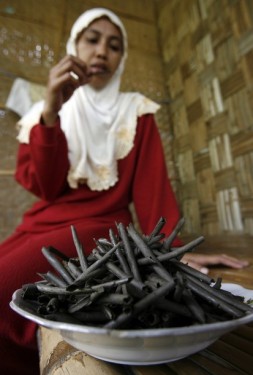 When I was little, I built this little toy settlement with animal figurines that I collected over the years. One of my ladies, an inch-tall cat with apron and yellow dress, was a baker, and I would gather water droplets on the garden leaves each morning so that she could bake cakes for the village. Apparently the best thing my imagination could come up with was a “soil cake”. Yep, I said my baker would collect the best dirt in her backyard, wash and knead it with morning dew, then make pastry out of it. Crazy, you say? Well, apparently a group of Indonesian villagers agree with my cat patisseur. Have you heard of ampo cake? I did just last night. ampo snack at Tuban village, East Java Province, Indonesia – Image courtesy of OddityCentral.com The ampo snack, made entirely of clean, gravel-free earth from paddy fields, can be eaten like crème roulée. I’m not sure what they mean by “clean” in the context of dirt. Regardless, Tuban villagers also believe that these supposedly cool, creamy baked rolls of soil are an effective pain-killer and skin-nourishing product. (From Reuters) Continue reading Think twice before you say ew
|
|
Blogs we read
|












